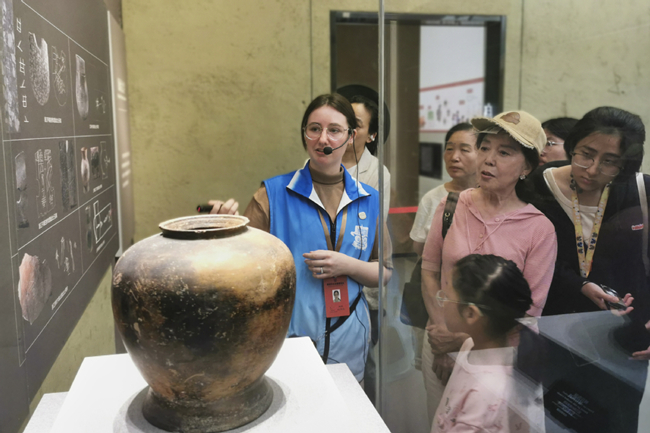an american guide for a chinese museum
long before smartphones and wechat, liangzhu's people were 'posting their moments' on pots, revealing the unesco heritage place's rich and interesting past

emma chen (extreme left) talks about the stories behind the ring-footed black pottery jar with 12 symbols to visitors in the liangzhu museum in hangzhou, zhejiang province, in may. [china daily]
the liangzhu museum in hangzhou, zhejiang province, houses a treasure trove of jade, lacquerware and myriad artifacts, but what has impressed emma chen, a volunteer there, the most is its black pottery collection, which sports unique symbols that some scholars think are inscriptions from another era. she passionately explains to visitors that long before smartphones, the liangzhu people were possibly "posting their moments" on pottery like people today do on wechat.
located on the outskirts of hangzhou, liangzhu museum, established in 2005, showcases the archaeological findings from the liangzhu ruins.
what has caught chen's attention the most is a ring-footed black pottery jar that bears 12 symbols. some scholars feel it tells a story. "one version is that it says that a man caught a tiger with a net," chen said. "there are many different explanations, but they were probably depicting specific scenes or events, inscribing on a pot what had happened earlier that day, the way people these days post moments on wechat," she said.
though she has a partially chinese name and speaks fluent mandarin, chen is from the united states, making her an unlikely guide for china's ancient past.
her knowledge of museums is extensive and her enthusiasm bridges centuries. chen has the knack of captivating visitors by making the ancient feel familiar.
she even quizzes visitors, asking them if they thought a wooden well, unearthed in liangzhu and dating back over 5,000 years, was real.
looking at it many of them say it can't be authentic as the wood would have decayed long ago. but chen corrects them.
"that's what we learn from archaeology, that objects submerged under water are often better preserved," she said, adding that the well stood as an example of how the ancient liangzhu people knew about water conservancy.
-
wu's unwavering belief
october 8, 2024
-
record-breaking achievements made at 3rd global digital trade expo
september 30, 2024
-
hangzhou prepares to welcome guests for 3rd global digital trade expo
september 23, 2024
-
on board g8388: lost in the qiandao lake — a unique aerial island maze
september 29, 2024

